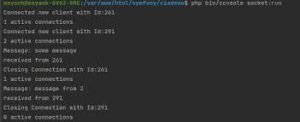-

-
Building a Scalable Real-Time Chat System with PHP & WebSocket
WebSockets enable real-time, two-way communication between clients and servers. They’re ideal for building chat systems that require instant messaging with minimal delays. This guide will walk you through building a scalable, efficient real-time chat system using PHP and WebSocket.

-
Why WebSockets for Real-Time Chat
-
Benefits:
- Instant Messaging: Low-latency communication, no delays in message delivery.
- Reduced Server Load: A single open connection per client reduces resource consumption.
- Scalability: Handles thousands of concurrent users efficiently.
- User Experience: Provides seamless and uninterrupted messaging.
Core Features of the Real-Time Chat System
- Real-Time Messaging: Messages appear instantly with no delay.
- User Authentication: Secure access for logged-in users only.
- Chat History & Storage: Store chat messages for review in a database.
- Online/Offline Status: Display user availability in real-time.
- Typing Indicators: Show when users are typing.
Building the Real-Time Chat System with PHP & WebSocket
1️⃣ Setting Up the WebSocket Server
The WebSocket server handles persistent connections between clients and the server.
2️⃣ Designing the Chat Interface
Ensure a clean, user-friendly design that supports messaging, images, emojis, and responsive behavior.
3️⃣ Securing User Authentication
Ensure that only authorized users can access the chat system by using JWT for secure WebSocket connections.
4️⃣ Storing Messages in a Database
Create a MySQL table for storing messages.
5️⃣ Optimizing for Performance
Optimize the chat system for high traffic:
- Redis Caching: Reduce database load.
- Load Balancing: Distribute traffic across multiple servers to prevent overload.
Challenges Faced & Solutions Implemented
- Managing Multiple Connections:
Solution: Used connection pooling and multi-threading. - Data Security:
Solution: Implemented JWT and end-to-end encryption. - Handling High Traffic:
Solution: Redis caching and load balancing.
Future Enhancements
- File Sharing: Allow sending images/documents.
- Group Chats: Support for multi-user conversations.
- Push Notifications: Notify users of new messages.
- AI Chatbot: Integrate AI for automated responses.
Conclusion
Building a scalable real-time chat system with PHP and WebSocket ensures fast, efficient, and secure messaging. With proper optimizations and future enhancements, you can create a robust solution that meets the demands of modern web applications.
Further Resources:
Tags
calendar_month
: January 29, 2025





